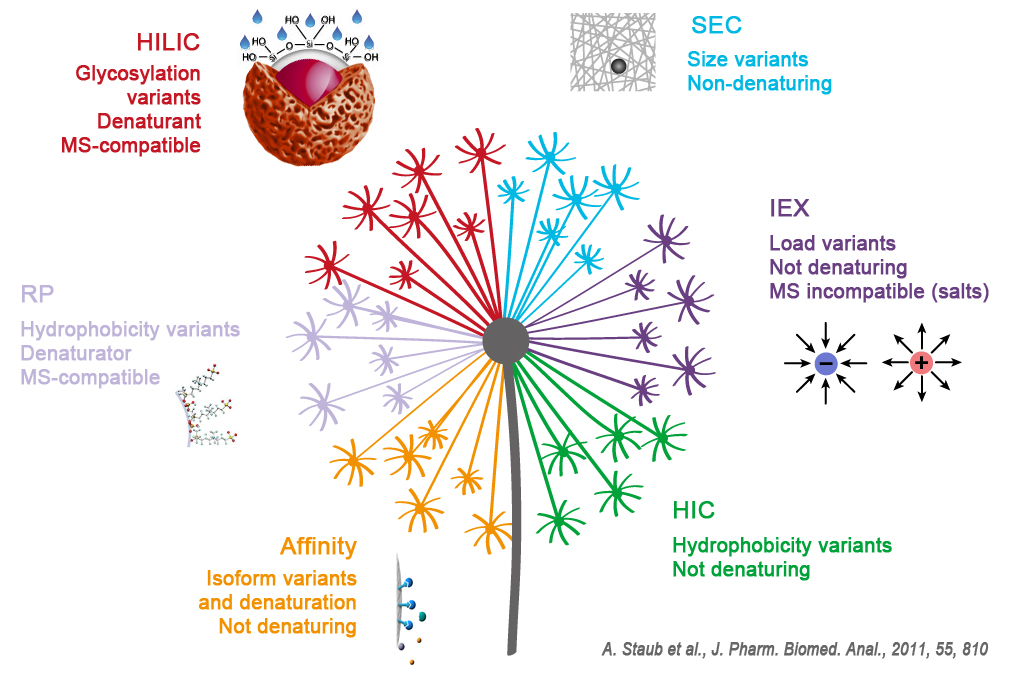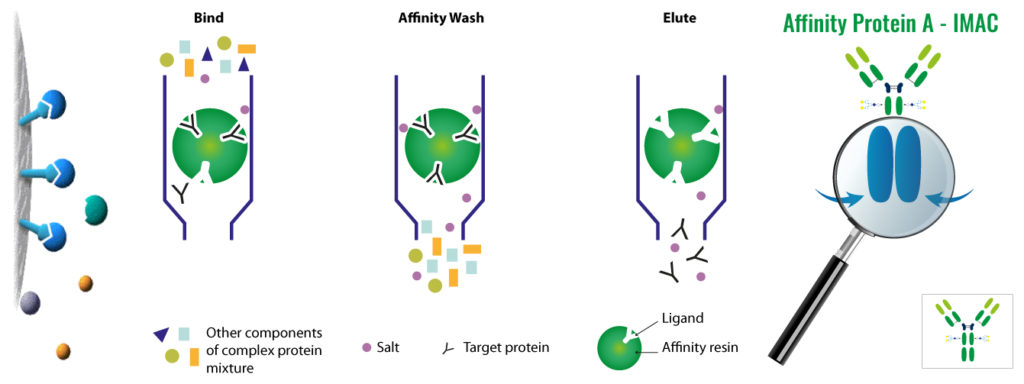Continuing our series on protein purification techniques, last month we discussed ion exchange chromatography (IEX). Today, we’re shifting focus to affinity chromatography—a highly efficient method among all protein purification techniques. It boasts the ability to purify proteins with an impressive level of purity, often reaching up to 90%.
Affinity chromatography offers a diverse portfolio of methods, including Protein A affinity, Immobilized Metal Affinity Chromatography (IMAC), and GST-Tag affinity, each tailored to specific applications.

## What is Affinity Chromatography?
Affinity chromatography is a selective separation process designed to isolate active biomolecules from their inactive or denatured counterparts. This separation relies on specific interactions between an immobilized ligand and its binding partner—such as antibody/antigen, enzyme/substrate, or enzyme/inhibitor.

### Advantages:
- **Exceptional Selectivity:** Achieves purities ranging from 80% to 90%.
- **Efficient Process:** Many proteins can be purified in just one or two steps.
- **Concentration Enhancement:** Helps concentrate proteins effectively.
- **Universal Conditions:** Often requires minimal optimization.
- **Rapid Processing:** Offers a fast and reliable purification process.
### Drawbacks:
- **Higher Cost:** Particularly true for certain ligands like Protein A.
This technique is particularly favored for purifying antibodies and recombinant proteins due to its precision and efficiency.
## Classic Affinity Chromatography Setup

Affinity chromatography operates on the principle of specific interactions between the biomolecule of interest and its corresponding ligand. These interactions are typically based on the biological function or unique chemical structure of the molecule. The biomolecule is loaded onto a column containing an immobilized ligand. The bound molecules are then eluted using changes in the mobile phase composition.
### How Does Affinity Chromatography Work?
At its core, affinity chromatography leverages the specific interactions between biomolecules to achieve high-selectivity separations. Unlike other chromatographic methods, this technique focuses on the unique biological function or structural features of the target molecule. By immobilizing the ligand on a chromatographic resin, the system can selectively capture the desired biomolecule. Elution occurs when the mobile phase conditions are altered, releasing the bound biomolecule.
Key benefits include:
- High selectivity
- Excellent resolution
- Significant capacity
The degree of purification can reach thousands of times over, and the yield is generally quite high. Affinity chromatography stands out because it uses the biological function of the target molecule as its basis.
### Common Adsorbents for Natural or Recombinant Proteins:
- **Protein A:** Ideal for antibody purification.
- **IMAC (Immobilized Metal Affinity Chromatography):** Effective for histidine-tagged proteins.
- **Glutathione:** Used for GST (glutathione S-transferase)-tagged proteins.
---
If you'd like to learn more about these techniques, feel free to explore further resources:
- **Contact Us:** [Your Contact Information]
- **Website:** [www.interchim.com](http://www.interchim.com)
- **Products:**
- FT - WorkBeads affimAb
- FT - BabyBio IMAC Kit
- FT - BabyBio Ni-NTA
- FT - WorkBeads IMAC
Feel free to reach out if you have any questions or need assistance!
AKD Special Starch
Application: used in AKD Emulsifier
Product Type: Cassava starch imported from China
Chemical composition: Tapioca starch
Appearance:White powder
Moisture ( % ): ≤ 14.0
Spots ( a / cm2): ≤ 2
Viscosity: 20 ~ 50 s (20%, 40 °C, 4 # Tu's cup)
pH value: 6.0 ~ 7.5
Toxicity: No harm to human health during operation and use
Storage: Store in a cool , dry, ventilated warehouse
Nature: white, gelatinization in low temperature , good fluidity , viscosity stability, aging resistance , the film is good , strong bond , fast drying . Products with low protein content , gelatinization liquid not perishable , no foam , no smell. Good adhesion properties of various fibers , high compatibility with other additives . For AKD emulsifier, the rational use of the product can effectively ensure emulsifying effect and reduce production cost.
Dosage: Production of one ton of 25% emulsifier simply add 192kg of the product
Packing: 25 kg / bag.
|
Product
Introduction :
|
|
Specification of AKD Special Starch
|
|
Application
|
Applied to the AKD emulsion
|
|
Production type
|
Modified imported cassava starch from
Thainland
|
|
Chemical component
|
Cassava starch
|
|
Appearance
|
White powder
|
|
(%)Moisture
|
≤14.0
|
|
Speckle per cm2
|
≤2
|
|
PH value
|
6.0~7.5
|
|
Fineness
|
≥98 %(100Mesh
fineness)
|
|
Whiteness
|
≥90
|
|
Viscosity
|
20~50 s( 20 %,40 ℃,4#Tushi Cup)
|
|
Toxicity
|
Harmless to human
|
|
Storage
|
In cool, dry and ventilated warehouse
|
|
Properties
|
High whiteness, low pasting temperature, good
futility, ageing resistance and film-processing ability, strong bond
stress, quick to dry;low
protein content, the paste is difficult to decay, foam free and free from
extraneous odor;good adhesiveness to fiber and
good solubility with other aiding agent. Used in AKD emulsion properly and guarantee
emulsion effection and cut cost.
|
|
Dosage
|
192kg for 1ton of 25% emulsion
|
|
Packing and transportation
|
25kg /bag
|
|

Akd Special Starch,Oxidized Starch,Starch For Akd Emulsifer,Cassava Starch
Shandong Tiancheng Chemical Co., Ltd. , https://www.tianchengchemical.com
